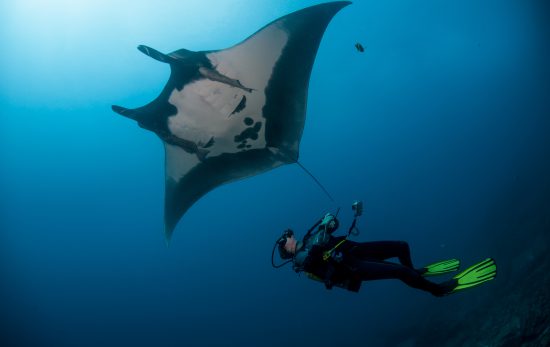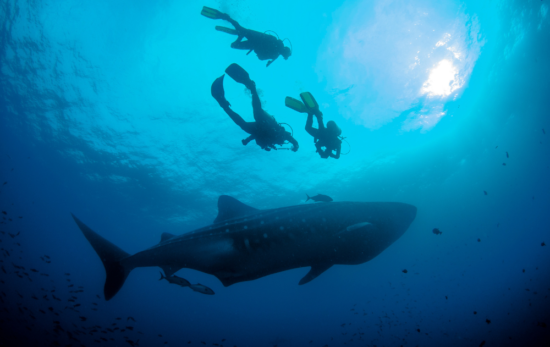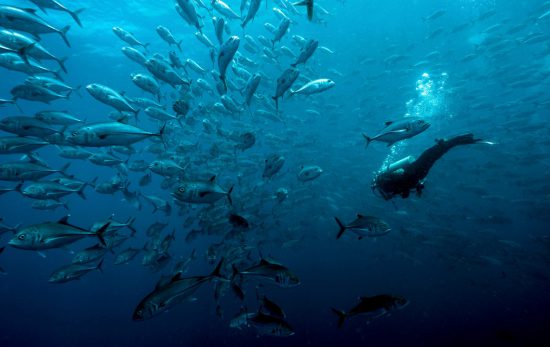When you think of scuba diving, Colombia may not be the first place that pops into your mind. However, the country is home to some of the best diving, including one of the best liveaboard diving destinations in the world.
Tucked away in the eastern Pacific Ocean, 500 kilometres (300 miles) off the Colombian mainland, lies Malpelo Island. This small, rocky outpost may not seem like much on the surface, but the island’s true treasures lie beneath the waves. At depth, scuba divers will find one of the largest shark populations in the world.
On any given dive, you might swim with 200 to 300 hammerhead sharks and hundreds of silky sharks. Whale sharks, eagle rays, tuna, sailfish and even whales also visit this underwater ridge.
This is shark diving at its best, and it can only be found at Malpelo Island.
The Malpelo Fauna and Flora Marine Sanctuary
The Malpelo Fauna and Flora Marine Sanctuary is a protected marine area and has been recognized as a UNESCO World Heritage Site since 2006. Spanning over 857,150 hectares, the marine park encompasses Malpelo Island and its surrounding marine environment. This huge park once represented the largest no-fishing zone in the Eastern Tropical Pacific Ocean.
The Colombian government, in collaboration with international organizations, has implemented strict conservation measures to safeguard the island’s biodiversity. These efforts include monitoring programs, research expeditions, and community engagement initiatives to raise awareness about the importance of marine conservation.
This vast sanctuary serves as a vital refuge for numerous internationally threatened and endangered species including sharks, billfish and giant groupers. Malpelo’s protected waters also offer a rare opportunity to encounter the elusive short-nosed ragged-toothed shark.
As one of the top scuba diving destinations in the world, Malpelo’s underwater environments boast steep walls and caves that support populations of over 200 hammerhead sharks and 1,000 silky sharks. In this undisturbed environment, these sharks can maintain their natural pattern of behavior.
Hammerhead Triangle
Much like the Bermuda Triangle, the Hammerhead Triangle is an imaginary geometric formation. Its corners are formed by Cocos Island, the Galapagos Islands and Malpelo. All three of these destinations are well-known in the scuba community for diving with masses of hammerhead sharks.
Within this triangle, you’ll sometimes have the opportunity to swim with shark schools numbering between 200 and 300 individuals. Challenging conditions prevail, but where currents rage and marine life concentrates, epic diving ensues.
Situated west of Central and South America, all of the islands in the Hammerhead Triangle are 500 to 1,000 kilometers (300 to 600 miles) from the mainland. Therefore, you’ll most likely need to travel by liveaboard to experience some of the best hammerhead diving in the world.

How To Get to Malpelo
Malpelo Island lies 310 miles (500 kilometers) west of the Colombian mainland. The only way to get there is by liveaboard. These trips usually depart from the small port of Buenaventura, a two-and-a-half hour drive from Cali, Colombia where Alfonso Bonilla Aragon Intl (CLO) is located.
Once you arrive in Buenaventura, you’ll embark the liveaboard and depart to Malpelo Island. The trip between the mainland and this remote piece of rock takes between 30 and 40 hours over sometimes rough seas. It might seem like a difficult journey, but it’s worth it for some of the best shark diving in the entire world.
Liveaboard trips to Malpelo generally last 9 to 11 nights and offer the opportunity to dive with various shark species and the other incredible marine life that inhabit the area. Visitors must follow strict regulations to protect the island’s delicate ecosystem. Despite the challenges of getting there, Malpelo Island is a once-in-a-lifetime destination for divers, adventurous travelers, and nature enthusiasts.

The Best Time To Dive Malpelo
Diving in Malpelo is possible year-round due to its tropical climate.
Dry season is January to May. During these months, you’ll experience a generally sunny climate with higher than usual seas. Shallow thermoclines complement colder water, which averages between 59°F and 68°F (15°C and 20°C). In addition, the high concentration of plankton hinders visibility. If you want to see hammerhead sharks, January to May is the best time to dive Malpelo. It’s also a great time to encounter small-tooth sand tiger sharks.
On the other hand, June to December represents the wet season. Visibility improves during these months, and you’ll experience calmer seas, deeper thermoclines and warmer waters with temperatures between 78°F and 82°F (26°C and 28°C). Silky sharks (May to July) and whale sharks (July to September) can be seen during the wet season.
How To Dive in Malpelo
Malpelo Island restricts and regulates diving due to its status as a protected marine reserve managed by the Colombian government and designated as a UNESCO World Heritage Site. This remote locale is a haven for numerous marine species, many of which are endangered. This offers unparalleled opportunities to observe sharks, including hammerheads, in their natural habitat.
Since 2018, only operators departing from Colombia are permitted to enter the marine park. In addition, only one liveaboard is allowed inside the park’s borders at any given time.
At the time of writing, the only dive operator with scheduled trips to Malpelo Island is the Ferox Liveaboard. (The Sea Wolf also makes trips to Malpelo, but it is currently only available for full charters.)
Reaching an island 300 miles (500 kilometers) off the mainland is no easy task. Commissioned in 1991 and fully refitted in 2017, the Ferox is a former Ice Classed Mine Layer. She has an 11mm armored steel hull, all new machinery and electronics as well as an extensive list of safety equipment on board. The clear goal is to offer one of the safest dive liveaboards in the world.
The Ferox can accommodate a maximum of 12 guests in 8 cabins, most of which boast ensuite facilities, comfortable beds and hypoallergenic towels. In addition, the bathrooms have all environmentally friendly toiletries. An internal telephone makes inter-boat communication a breeze and sound proofing allows you to get a better night’s rest. It may be a beast of a boat, but it was refitted with the comfort of divers in mind.
Be aware that liveaboard is the only option diving at Malpelo Island.

Diving and Marine Life in Malpelo
Diving in Malpelo Island is epic. Here are a few of the highlights:
- Nowhere else in the world can you dive with so many sharks and big fish.
- You will encounter awe-inspiring schools of hammerhead sharks, reaching up to 300 individuals.
- And you’ll see enormous congregations of silky sharks mixed in with the hammerhead sharks.
- Free swimming moray eels are also a common sight.
- Whitetip and Galapagos sharks, sailfish, whale sharks, jacks, tuna, schools of angelfish and even humpback and blue whales often make an appearance.
Malpelo Island itself is a forbidding rock formation that rises up from the fantastic depths of the Pacific Ocean. Dive sites around the island feature mostly steep walls and pinnacles attached to an undersea ridge. There are also caverns and some sandy bottoms to explore.
It is important to note that Malpelo Island features strong and changing currents as well as occasional rough seas. Most dives here are drift dives. Therefore, it is recommended that divers hold an advanced certification with more than 50 dives in their logbooks before booking this trip.
Overall, diving in Malpelo Island offers a truly spectacular opportunity to witness some of the most incredible marine life on the planet, in a protected and unspoiled environment.
Why Is Malpelo Island a Hotspot for Marine Life?
Complex interactions between ocean currents, marine life and geological features make the waters around Malpelo a truly unique and mysterious place. An oceanographer’s dream, this underwater mountain, known as a seamount, creates a hotspot for biodiversity. Mixing ocean currents and upwellings brings an influx of nutrient-rich waters from the depths. This then fosters the growth of phytoplankton and supports a thriving marine ecosystem. At the top of this ecosystem, apex predators (sharks) thrive, an increasingly rare sight in a world of overfishing. The extraordinary position of Malpelo combined with its unique marine features creates an ocean oasis for wildlife. Only the most dedicated adventure seekers can witness it first-hand.
Additionally, the waters around Malpelo act as a migration corridor linking the Cocos and Galapagos islands to Malpelo. Along this route some species of shark travel to give birth, feed and mate.
Understanding the intricacies of Malpelo’s oceanography is key to appreciating its ecological significance and the importance of conservation efforts in safeguarding this Hope Spot.
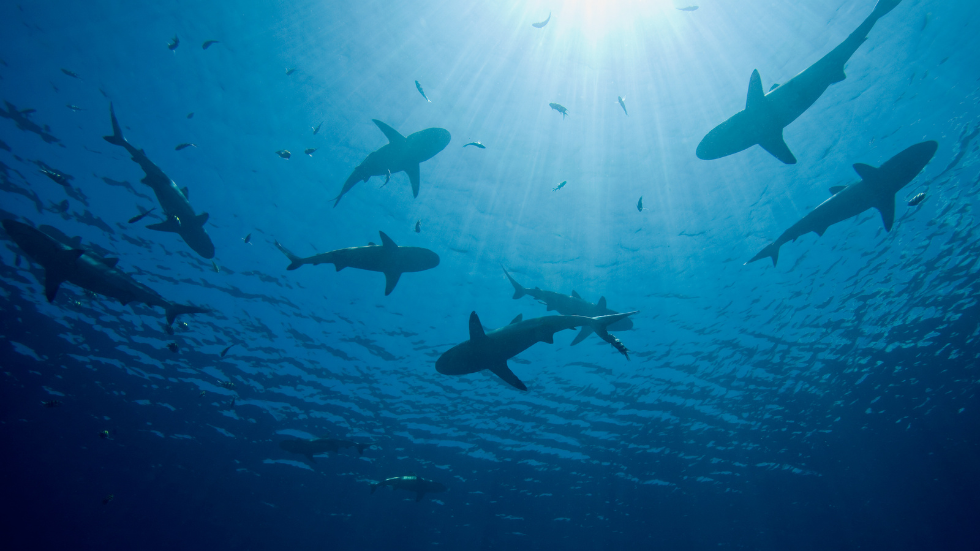
Malpelo Is the Shark Diving Capital of the World
There are several reasons why there are so many shark species in Malpelo. Firstly, because Malpelo is located in the Eastern Tropical Pacific, it has a naturally high level of biodiversity and abundance of marine life. The island’s rocky terrain provides a variety of habitats for different species of sharks, including caves, walls, and pinnacles. These habitats attract a diverse range of prey species.
Additionally, Malpelo is situated in a convergence zone where different ocean currents meet. This creates a nutrient-rich environment that supports a thriving ecosystem of pelagic species, including tuna and other large fish, which are prey for sharks.
Moreover, the area’s protected status as a UNESCO World Heritage Site has allowed for the conservation of the marine environment, ensuring that shark populations can thrive without excessive human disturbance.
Finally, Malpelo’s remoteness and low tourism impact means that the area has remained relatively untouched and pristine. This provides a healthy habitat for a wide range of marine life. In summary, the combination of Malpelo’s location, ocean currents, marine habitats, and conservation status have all contributed to the rich diversity and abundance of shark species in the area.
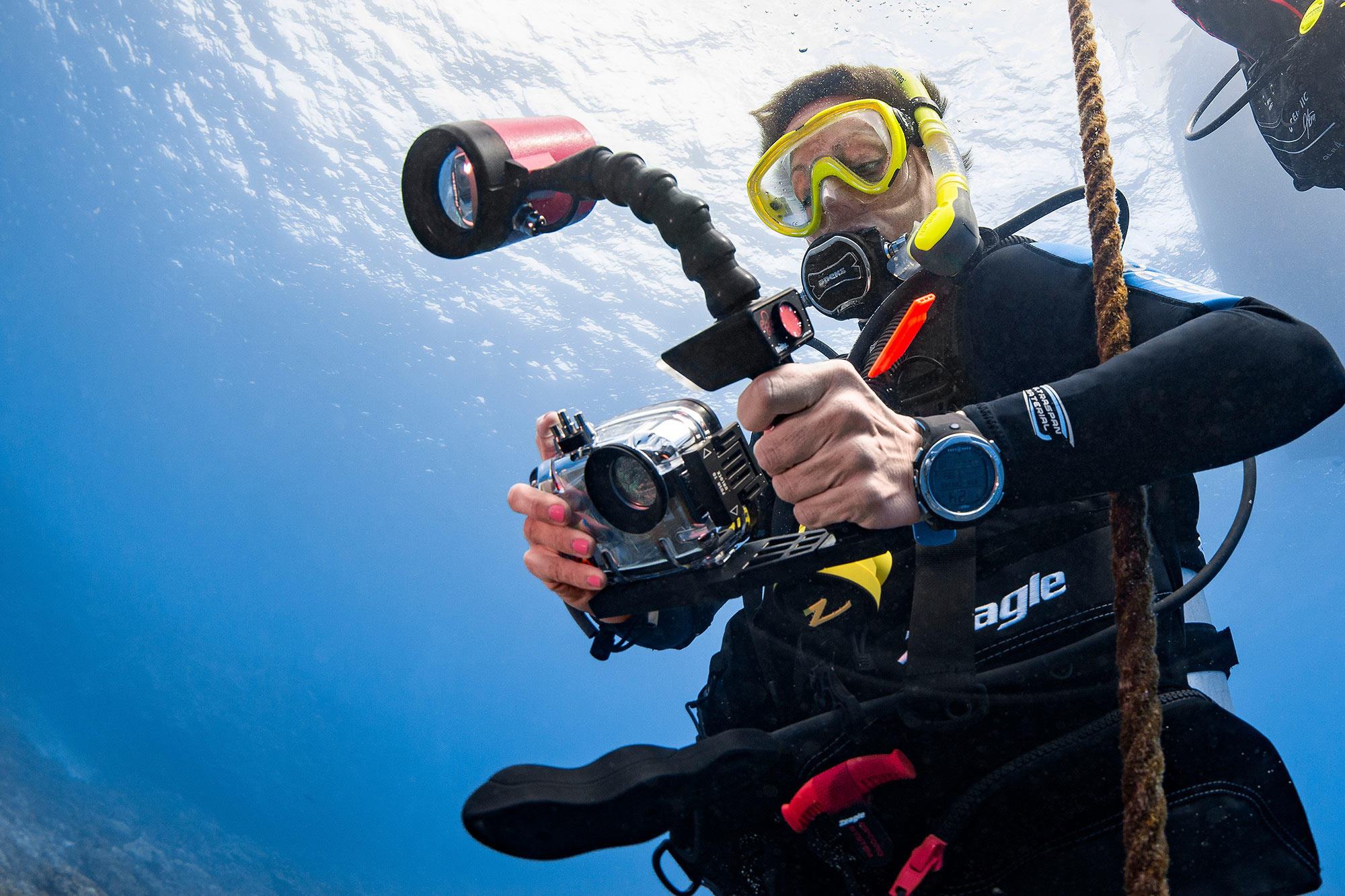
Capturing Malpelo’s Essence With Underwater Photography
The waters around the island are incredibly clear! Visibility ranges from 20 to 40 meters (approximately 65 to 130 feet), making it an ideal location for underwater photography and video.
Therefore, it’s worth taking a PADI Digital Underwater Photographer course before your trip. This way, you can make the most of your travels and capture the essence of Malpelo’s underwater realm. Learn how to compose stunning shots of hammerhead sharks gliding gracefully through the depths, silky sharks swirling in mesmerizing patterns, and vibrant coral gardens teeming with life. From mastering lighting techniques to selecting the perfect camera settings, you can immortalize your Malpelo diving adventures.

Experience Nature Unfiltered
Divers often experience amazing encounters with marine life when they are diving. This is because they are entering a world that is vastly different from their own. When divers immerse themselves in the underwater environment, they become part of the ecosystem, and divers are able to witness the behavior and interactions of marine life up close.
This proximity allows for unique and unforgettable experiences, including swimming alongside a school of fish, watching an eagle ray glide effortlessly through the water, or even coming face to face with a massive whale shark. Encounters can be both exhilarating and humbling, to witness the power and grace of these creatures in their natural habitat.
Furthermore, diving offers an unparalleled opportunity to develop a deep appreciation and understanding of intricate and diverse marine ecosystems. Divers who have the privilege of experiencing these encounters with marine life often find themselves forever changed by the experience. Most develop a newfound respect and reverence for the natural world.
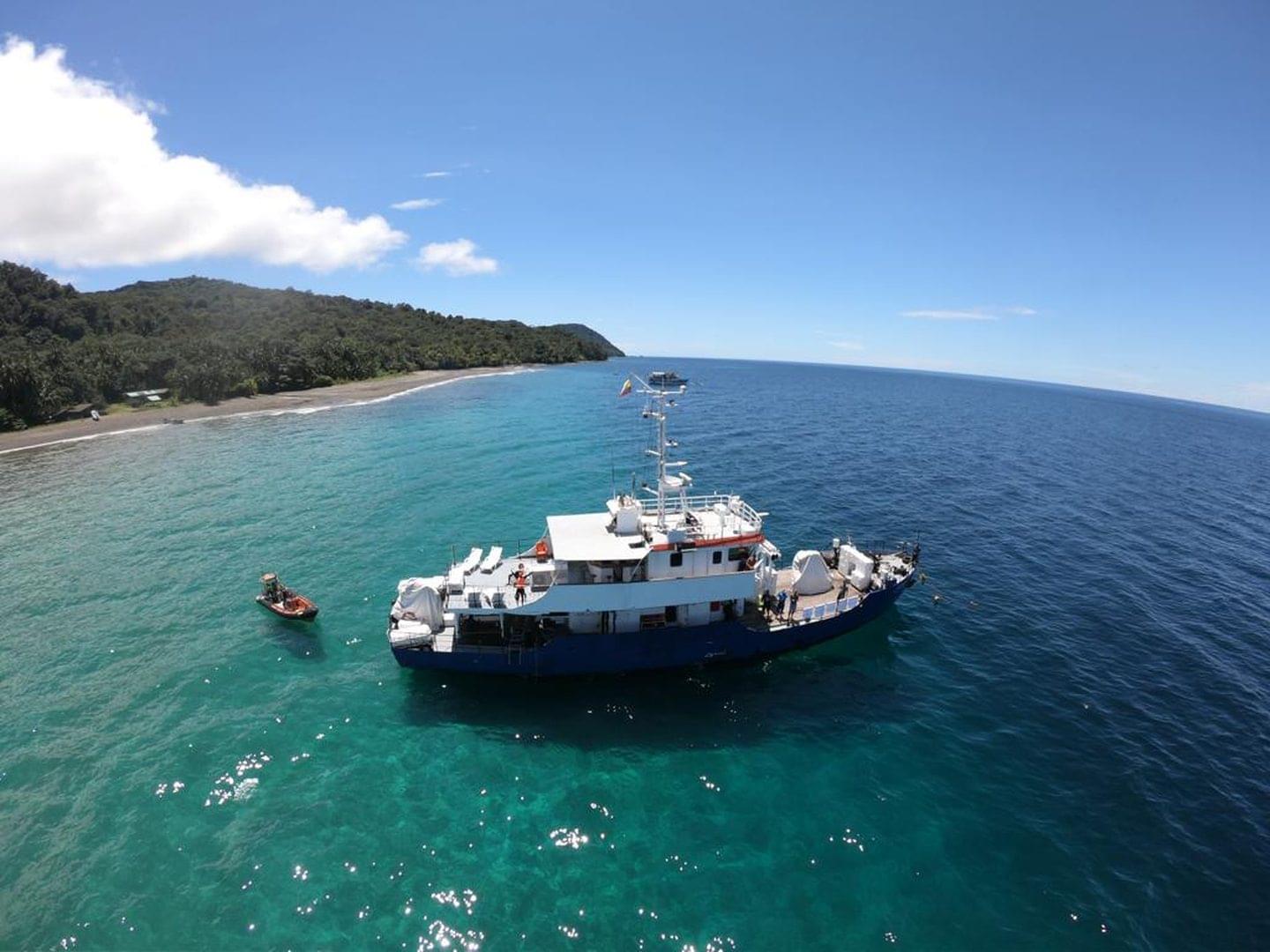
Book Your Liveaboard Trip to Malpelo
As previously mentioned, since 2018, only one liveaboard is allowed inside the Malpelo marine park at any given time. Currently, the Ferox is the only dive operator with scheduled individual trips to Malpelo, which you can book via PADI Travel conveniently online.
Book your next scuba holiday today or get in touch with us to learn more about the remote Colombian island known as Malpelo.
